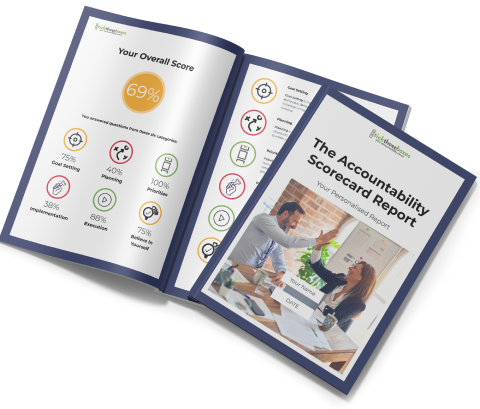
Posted on: 12/04/2023

The University of Warwick conducted a rather interesting study – a couple of experiments led by Dr Daniel Sgroi, Professor Andrew Oswald, and Dr. Eugenio Proto found that the happier a person is, the more productive they become.
While a good portion of the world may be unaware of this, Google sure is no stranger to the rewards of a happy workforce – the search engine giant’s growth improved by a whopping 37% simply by focusing on employee happiness and boosting their morale.
However, what is the best way to go about this? Most certainly not installing another coffee machine or serving an all-you-want-to-eat buffet on Saturdays! The secret sauce behind satisfied employees is the simple act of positive accountability.

Discover your Accountability Score and increase the probability of smashing your GOALS and Getting Sh!t Done!
Some people even mistake accountability for micromanagement! Thankfully, the true definition includes none of that dreadful stuff. Let’s understand the term using The Oz Principle. According to this principle, (positive) accountability is merely the desire to rise above one’s current circumstances and showcase the necessary ownership to reach desired goals.
Employees driven by positive accountability are able to see their daily work as a joy rather than drudgery. Also, when unforeseen challenges arise, they feel empowered to take relevant actions instead of being paralysed by fear.
Once leaders have defined accountability well, they can begin to understand different ways in which this simple act can motivate employees to take better decisions. All of this ultimately enhances employee morale and increases job satisfaction.
Who doesn’t like to be in control of the situation, of their work, and of life in general? When employees are offered the driver’s seat, they tend to take better ownership of their work.
Because it is within their power to perform meaningful work, they are more likely to take care of its quality and turnaround. Constant nit-picking and pointing of fingers can demoralise even the best of us. This is why ownership of work also improves employee engagement and reduces company turnover.
Contrary to mainstream belief, no healthy individual enjoys procrastination. This practice is a sure sign for someone who is struggling to find meaning in their work.
Since it is a purpose that brings job satisfaction and a sense of fulfilment, positive accountability works wonders. It offers employees a clear idea of their involvement in the company’s larger picture. This instils a sense of purpose and pushes employees to do their best in their daily projects.
When an employee finds meaning in their work, they are also able to navigate monotony, which is a part of every job, at least to some degree.
When each team member is held accountable for their role, there are clearly defined expectations. This eliminates confusion to a great extent and saves much time.
Occurrences of blame-shifting were reduced, and no employee felt underworked or over-pressured to drive results. Over time, work culture strengthens because people can admit errors without fearing the blame.
Let’s be honest – nobody enjoys working in a place they can’t seem to trust others an inch. Breeding positive accountability is all about introducing work with integrity.
This means everyone trusts the other when it comes to meeting deadlines, ensuring proper quality checks and even timely communication in case a roadblock is discovered. Employees look forward to working because they know they can communicate openly and work with transparency.
As a leader, you must know that accountability can be a challenging course to traverse. This is mainly because while most employees crave accountability, they might also fear it at the same time. Why? Because of the impending punishment for not meeting the expectations.
So, how can you create safe accountability that shifts the focus from mistake-monitoring to celebrating accomplishments? Follow these quick tips!
Finally, The Oz Principle’s definition of accountability only works in scenarios where accountability is treated as a two-way street. As much as leaders are expected to hold their team members accountable, they must be willing to assume the same responsibility.
This helps in leading by example, solidifies trust, encourages open communication, and fosters meaningful workplace relationships. They say it right when they say that the most successful leaders leave behind an enduring legacy of not just growth but also of service.
As they hold others accountable, they are also open to upholding themselves to a greater standard of conduct and behaviour.
I was excited to join Tia Harmer on The Work in Progress: The Personal Productivity Science Insights Podcast! We dive deep into the science of goal setting and the power of accountability—two cornerstones of business and personal success.